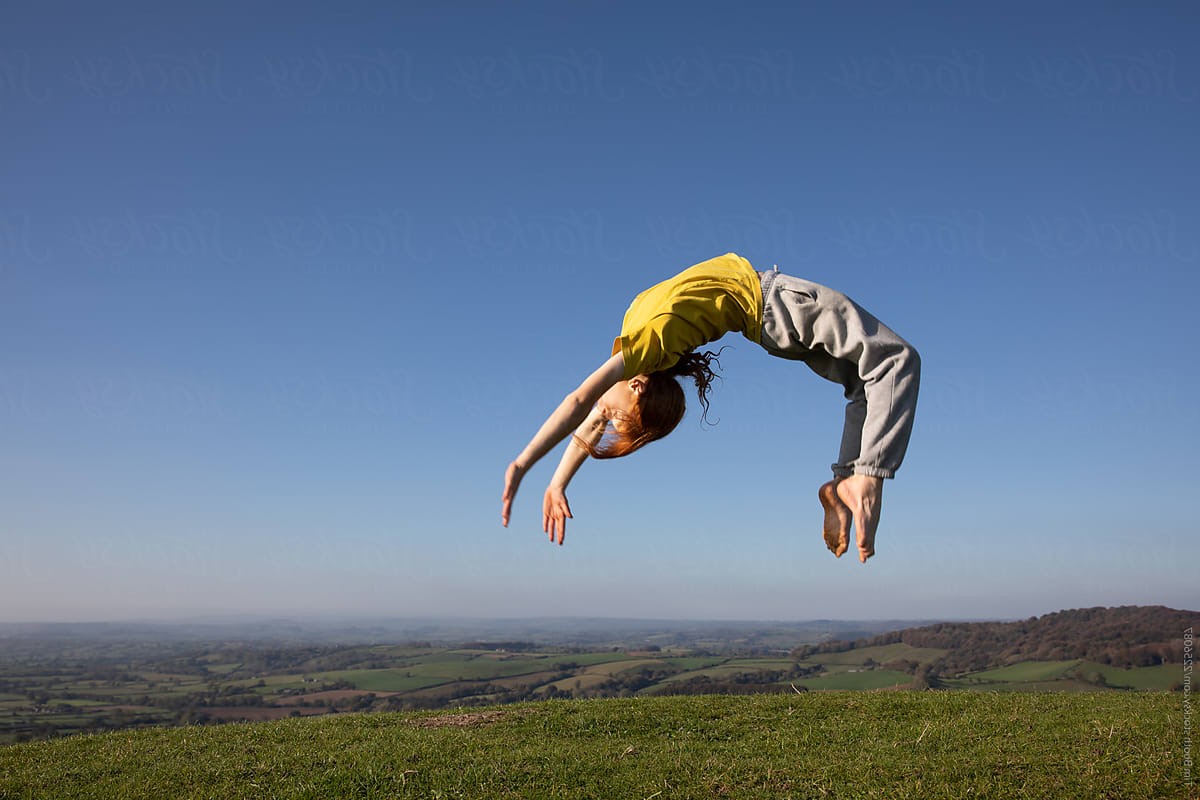

Sports
How To Do A Backflip
Published: February 26, 2024
Learn the proper technique and training tips for mastering the backflip in sports. Discover step-by-step instructions and safety precautions to execute a perfect backflip. Start your journey to backflip success today!
(Many of the links in this article redirect to a specific reviewed product. Your purchase of these products through affiliate links helps to generate commission for Noodls.com, at no extra cost. Learn more)
Table of Contents
Introduction
Performing a backflip is a thrilling and awe-inspiring feat that showcases agility, strength, and fearlessness. Whether you're an aspiring gymnast, a parkour enthusiast, or simply eager to master an impressive skill, learning how to execute a backflip can be an exhilarating journey. This acrobatic maneuver, characterized by a backward rotation in the air, has captivated audiences for generations with its display of athleticism and grace.
Embarking on the quest to master the backflip requires dedication, patience, and a deep understanding of the mechanics and techniques involved. It's not merely a physical endeavor but also a mental challenge that demands focus, confidence, and a willingness to push personal boundaries. As you delve into the world of backflips, you'll discover the intricate interplay of physics, biomechanics, and sheer determination that underpins this remarkable skill.
In this comprehensive guide, we will delve into the art of performing a backflip, breaking down the process into manageable steps that cater to beginners and seasoned practitioners alike. From understanding the fundamental mechanics of a backflip to preparing your body for the physical demands, and from learning the technique to practicing safely, each aspect will be explored in detail. By the end of this journey, you will not only grasp the technical aspects of executing a backflip but also gain valuable insights into the mindset and discipline required to master this exhilarating maneuver.
So, fasten your seatbelt, metaphorically speaking, and get ready to embark on an exciting adventure into the world of backflips. Whether you're aiming to impress your friends, compete in gymnastics, or simply conquer a personal challenge, the knowledge and skills you'll gain from this guide will undoubtedly propel you closer to achieving your backflip aspirations. Let's dive in and unravel the secrets behind this gravity-defying move!
Read more: How To Do The Griddy
Understanding the Mechanics of a Backflip
Executing a flawless backflip is a harmonious fusion of physics, biomechanics, and precise muscle control. At its core, a backflip involves converting potential energy into kinetic energy, resulting in a graceful backward rotation through the air. To comprehend the mechanics of this aerial maneuver, it's essential to dissect the key elements that govern its execution.
1. Takeoff:
The backflip commences with a powerful and explosive takeoff. As the individual crouches and springs upward, the legs act as powerful pistons, propelling the body into the air. This initial burst of energy is crucial in establishing the vertical momentum necessary for the rotation.
2. Tucking and Rotation:
Once airborne, the body transitions into the tucking phase, where the knees are drawn towards the chest. This action initiates the rotational movement, effectively reducing the body's moment of inertia and facilitating a faster spin. The arms play a pivotal role in generating angular momentum, aiding in the rotation while maintaining balance and control.
3. Spotting the Landing:
Amidst the aerial somersault, the ability to visually spot the landing point is paramount. This involves a split-second glimpse of the surroundings to gauge orientation and prepare for a precise landing. Spotting the landing not only ensures a graceful descent but also minimizes the risk of disorientation upon touchdown.
Read more: How To Do Spoilers On Discord
4. Landing:
As the rotation nears completion, the body gradually unfolds, preparing for a smooth and controlled landing. The legs extend to absorb the impact, and the knees flex to cushion the landing, thereby dissipating the kinetic energy accumulated during the rotation.
5. Balance and Alignment:
Maintaining equilibrium throughout the backflip is essential. The body must remain aligned along the rotational axis, ensuring a stable and controlled spin. This demands a delicate interplay of muscular coordination and spatial awareness, culminating in a graceful and poised landing.
Understanding the intricate interplay of these mechanics is pivotal in mastering the art of the backflip. By dissecting each phase of the maneuver, aspiring practitioners can gain a profound insight into the physical principles that underpin this gravity-defying feat. With a solid grasp of the mechanics, the journey towards executing a flawless backflip becomes an exhilarating pursuit of finesse, control, and aerial prowess.
Preparing Your Body for a Backflip
Preparing your body for the demanding physicality of a backflip is a crucial step in mastering this acrobatic maneuver. It involves a holistic approach that encompasses strength, flexibility, coordination, and mental readiness. By diligently conditioning your body, you can minimize the risk of injury and optimize your performance, paving the way for a confident and graceful execution of the backflip.
1. Strengthening the Lower Body:
Building lower body strength is fundamental for generating the explosive power required to propel yourself into the air. Targeted exercises such as squats, lunges, and calf raises help fortify the quadriceps, hamstrings, and calf muscles, enhancing your ability to execute a forceful takeoff. Additionally, plyometric drills, including box jumps and depth jumps, can augment your leg power and explosiveness, essential for achieving the vertical lift-off crucial to a successful backflip.
Read more: How To Do A Burnout
2. Enhancing Core Stability:
A strong and stable core is indispensable for maintaining control and balance throughout the backflip. Engaging in core-strengthening exercises such as planks, Russian twists, and leg raises fortifies the abdominal, oblique, and lower back muscles, providing the necessary support for a controlled and coordinated rotation in mid-air. A robust core also aids in minimizing the risk of over-rotation and facilitates a seamless transition from takeoff to landing.
3. Flexibility Training:
Flexibility is a cornerstone of backflip preparation, as it directly influences the range of motion and fluidity of movement during the aerial rotation. Incorporating dynamic stretching routines that target the hip flexors, hamstrings, and lower back can significantly enhance your flexibility, enabling a more efficient tucking motion and a graceful extension during the landing phase. Yoga and mobility exercises can also contribute to improved flexibility and body awareness, essential for executing a technically proficient backflip.
4. Mental Conditioning:
Preparing for a backflip extends beyond physical training and encompasses mental fortitude and focus. Visualizing the entire sequence of the backflip, from the takeoff to the landing, can instill confidence and mental preparedness. Additionally, cultivating a resilient mindset, embracing the challenge with determination, and acknowledging the incremental progress during training are vital aspects of mental conditioning that contribute to a poised and confident execution of the backflip.
By diligently adhering to a comprehensive training regimen that encompasses strength, flexibility, and mental conditioning, you can prime your body for the exhilarating journey of mastering the backflip. This holistic approach not only minimizes the risk of injury but also fosters a deeper understanding of the physical and mental intricacies involved in this captivating aerial maneuver.
Learning the Technique
Mastering the technique of executing a backflip is a pivotal phase in the journey towards acrobatic prowess. This segment delves into the intricate details of the backflip technique, encompassing the nuanced movements, body positioning, and spatial awareness essential for a seamless and graceful execution.
Read more: How To Do Box Braids
1. Takeoff and Jumping Technique:
The takeoff phase is the foundation of a successful backflip. It demands a potent and explosive jump, achieved by driving through the balls of the feet and propelling the body upward with maximal force. The arms play a crucial role in this phase, as they swing upward to augment the vertical lift-off. Maintaining a strong and upright posture during takeoff is imperative, ensuring a powerful launch into the aerial rotation.
2. Tucking and Rotation:
As the body ascends, the tucking phase commences, characterized by swiftly drawing the knees towards the chest while maintaining a compact and aerodynamic form. This action initiates the rotational movement, reducing the body's moment of inertia and facilitating a faster spin. Simultaneously, the arms play a pivotal role in generating angular momentum, aiding in the rotation while maintaining balance and control.
3. Spotting the Landing:
Amidst the aerial somersault, the ability to visually spot the landing point is paramount. This involves a split-second glimpse of the surroundings to gauge orientation and prepare for a precise landing. Spotting the landing not only ensures a graceful descent but also minimizes the risk of disorientation upon touchdown.
4. Unfolding and Landing:
As the rotation nears completion, the body gradually unfolds, preparing for a smooth and controlled landing. The legs extend to absorb the impact, and the knees flex to cushion the landing, thereby dissipating the kinetic energy accumulated during the rotation. Maintaining balance and alignment throughout this phase is crucial, ensuring a stable and poised landing.
Read more: How To Do A Finishing Move In MW2
5. Practice and Refinement:
Learning the backflip technique necessitates dedicated practice and incremental refinement. Initiating the learning process with a foam pit or a spotter provides a safe environment to familiarize oneself with the movements and build confidence. As proficiency grows, transitioning to a trampoline can facilitate a more dynamic and controlled execution of the backflip. Gradually progressing to solid ground under the supervision of a trained instructor further refines the technique, culminating in a polished and confident execution of this acrobatic marvel.
6. Mental Preparation:
Beyond the physical aspects, mastering the backflip technique entails mental preparation. Cultivating a focused and resilient mindset, visualizing the sequence of movements, and embracing the learning process with determination are integral facets of mental conditioning. This mental fortitude complements the technical proficiency, fostering a holistic approach to mastering the backflip.
By immersing oneself in the intricacies of the backflip technique and diligently refining each phase through dedicated practice and mental fortitude, aspiring practitioners can inch closer to executing this gravity-defying maneuver with finesse, confidence, and artistry.
Practicing Safely
Practicing the backflip safely is paramount in the journey towards mastering this acrobatic maneuver. It involves a meticulous approach that prioritizes injury prevention, skill refinement, and confidence building. By adhering to stringent safety protocols and gradually progressing through structured training, practitioners can mitigate risks and cultivate a secure environment for honing their backflip proficiency.
-
Supervised Training: Initiate the practice sessions under the guidance of a qualified instructor or spotter. Their expertise and vigilance can provide invaluable feedback, ensuring proper technique and minimizing the likelihood of mishaps. The presence of a knowledgeable mentor fosters a supportive and secure environment, instilling confidence in the practitioner as they navigate the intricacies of the backflip.
-
Progressive Skill Development: Embrace a gradual and systematic approach to skill development. Begin with foundational exercises that simulate the backflip motion, such as tuck jumps and backward rolls, before progressing to trampoline-assisted backflips. This incremental progression allows for skill consolidation and confidence building, laying a robust foundation for the eventual execution of the backflip on solid ground.
-
Utilize Safety Equipment: When transitioning to solid ground practice, consider the use of safety equipment such as a spotting belt or crash mats. These protective measures serve as a safety net, offering reassurance to the practitioner and mitigating the impact of any potential missteps during the learning process. The presence of safety equipment instills a sense of security, enabling practitioners to focus on technique refinement without undue apprehension.
-
Mindful Environment: Cultivate a mindful and distraction-free practice environment. Eliminate potential hazards, ensure adequate lighting, and maintain a clutter-free practice area to minimize the risk of accidents. A serene and organized setting fosters concentration and allows practitioners to channel their focus entirely on the nuances of the backflip technique.
-
Physical Readiness: Prioritize physical readiness through comprehensive warm-up routines and conditioning exercises. Dynamic stretches, cardiovascular warm-ups, and targeted muscle activation drills prepare the body for the demands of backflip practice, reducing the likelihood of muscular strains and enhancing overall performance.
By embracing a safety-centric approach to backflip practice, practitioners can navigate the learning curve with confidence and resilience. Each practice session becomes an opportunity for skill refinement and incremental progress, underpinned by a steadfast commitment to safety and proficiency. This conscientious approach not only fosters a secure learning environment but also instills a deep appreciation for the artistry and discipline inherent in mastering the backflip.
Conclusion
In conclusion, mastering the art of the backflip is a multifaceted journey that intertwines physical prowess, mental fortitude, and technical finesse. From unraveling the intricate mechanics of the backflip to diligently preparing the body for the physical demands, and from learning the nuanced technique to practicing safely, each facet of this acrobatic marvel embodies a harmonious blend of athleticism and artistry.
Embarking on the quest to conquer the backflip is not merely a pursuit of mastering a physical maneuver; it is a testament to the resilience of the human spirit. It demands unwavering dedication, a willingness to embrace challenges, and the courage to push personal boundaries. The journey towards executing a flawless backflip transcends the realms of athleticism, delving into the realms of discipline, perseverance, and the relentless pursuit of excellence.
As aspiring practitioners immerse themselves in the intricacies of the backflip, they unravel the profound interplay of physics and biomechanics that govern this gravity-defying feat. The understanding of the mechanics becomes a cornerstone of their journey, empowering them with a profound insight into the physical principles that underpin the art of the backflip.
Preparing the body for the demands of the backflip entails a holistic approach that encompasses strength, flexibility, and mental conditioning. This comprehensive training regimen not only minimizes the risk of injury but also fosters a deeper understanding of the physical and mental intricacies involved in this captivating aerial maneuver.
Learning the technique of the backflip is a pivotal phase that demands meticulous attention to detail, dedicated practice, and unwavering mental fortitude. Each phase of the maneuver, from the explosive takeoff to the graceful landing, becomes a canvas for practitioners to weave a tapestry of agility, control, and aerial prowess.
Practicing the backflip safely is paramount, as it cultivates a secure environment for skill refinement and confidence building. By adhering to stringent safety protocols and embracing a gradual progression, practitioners can navigate the learning curve with resilience and determination, fostering a deep appreciation for the artistry and discipline inherent in mastering the backflip.
In essence, the journey towards mastering the backflip transcends the realms of physicality, evolving into a testament of human resilience, discipline, and the relentless pursuit of excellence. As practitioners navigate this exhilarating odyssey, they not only unravel the secrets behind this awe-inspiring maneuver but also embark on a transformative quest that celebrates the indomitable spirit of human endeavor.











